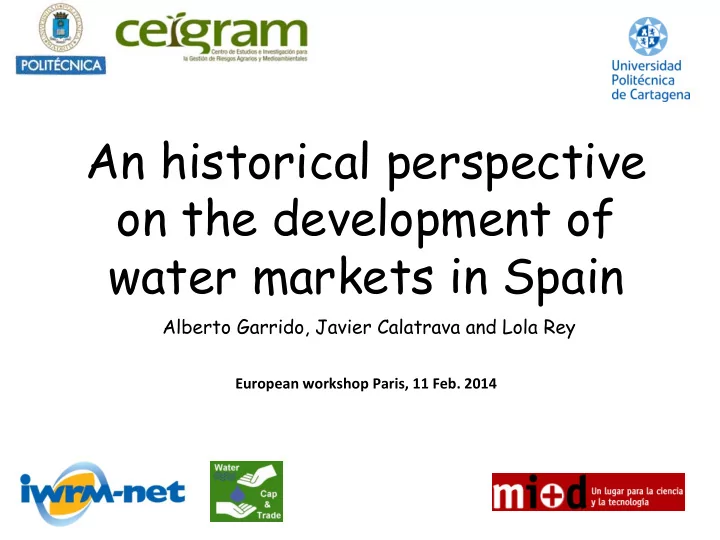

An historical perspective on the development of water markets in Spain Alberto Garrido, Javier Calatrava and Lola Rey European workshop Paris, 11 Feb. 2014
1. INTRODUCTION 1985: Surface water and groundwater : PUBLIC DOMAIN • The origin 1999 Reform of the Water Law • Law’s Preamble: “In this sense, the experience of the severe drought, …, on the other hand to increase water use efficiency it is required that the water use right system (the concessions) must be made more flexible, by means of a new contract for transferring water rights which permit socially optimising such a scarce resource”.
1. INTRODUCTION 1985: Surface water and groundwater : PUBLIC DOMAIN New irrigated areas 1990s: water demand Industrial activity Urban development Water scarcity problems in several areas of Spain Need of more flexibility (1999 Reform of the Water Law) • Allowing the temporary exchange of water concessions between users: -Formal lease contracts - Water exchange centres • Avoiding the creation of a real market for water (speculation)
2. Informal / formal trading
2. SPANISH WATER RIGHTS Typically water rights are made available through • publicly built infrastructures (dams or water transfers) or privately built with permission of the state (hydroelectricity). Restricted to the use for it was issued. • Rights appurtenant to a plot must be transmitted • with land. Rights can be forfeited by RBA if water is not used • by the holder.
4. PRICES • FORMAL LEASE CONTRACTS (Tagus Basin) – 38 000 €/year + a variable quantity of 0.04 €/m 3 for the first 4 hm 3 , and 0.02 €/m 3 for the rest of the total volume. • PUBLIC EXCHANGE CENTRE – Júcar: 0.13-0.19 €/ m 3 – Segura: average 0.168 €/ m 3 ; max 0.18 €/ m 3 • INTER-BASIN EXCHANGES – Tagus-Segura: 0.23-0.28 €/ m 3 ; 0.19-0.22 €/ m 3 – Negratín-Almanzora: 0.15-0.18 €/m 3
5. RECENT INSTITUTIONAL REFORMS • The Andalusian Law (2010) (with little geographical application, though, because the Guadalquivir is an inter-regional river): – Eliminates use priorities – Allows purchases for non-right holders – Creation of new Water Banks in 3 different basins in Andalusia. • A National reform ( Royal Decree 17/2012, May 4th, 2012): – Concerning groundwater rights.
6. REASONS BEHIND LIMITED SUCCESS OF WMS IN SPAIN • Restrictions and pre-requisites for the approval of the water exchange. • Water markets do not always work efficiently because water concessions were not designed for market transactions • Regulatory elements that hampers the market activity • rights to consumptive uses cannot be sold to holders of non-consumptive use rights (hydropower) and viceversa. • rights can only be leased out to other rights holders of an equivalent or higher category in the order of preference. • limits to the spatial extent of trading. • regulations may determine maximum prices for water licenses .
7. CONCLUSIONS • Water trading is a tool to cope with water scarcity and to improve water use efficiency • Water regulation should move towards a more flexible, agile and dynamic management system • The existence of informal water markets proves that there is a demand for the reallocation of water resources among users
THANK YOU alberto.garrido@upm.es j.calatrava@upct.es dolores.rey@upm.es www.ceigram.upm.es
Recommend
More recommend